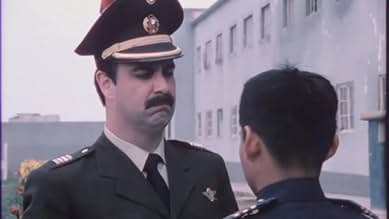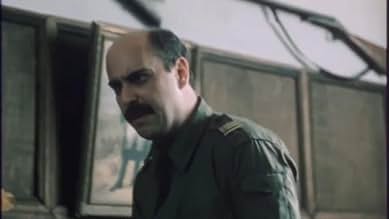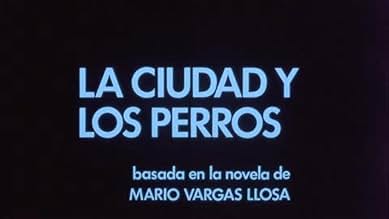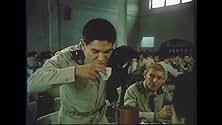IMDb RATING
7.4/10
778
YOUR RATING
Four angry cadets form an inner circle to beat the system, boredom and the stifling confinement of the military academy, sparking a chain of events that begins with a robbery and leads to mu... Read allFour angry cadets form an inner circle to beat the system, boredom and the stifling confinement of the military academy, sparking a chain of events that begins with a robbery and leads to murder.Four angry cadets form an inner circle to beat the system, boredom and the stifling confinement of the military academy, sparking a chain of events that begins with a robbery and leads to murder.
- Awards
- 2 wins total
Featured reviews
"La Ciudad Y Los Perros" (translated "The City and the Dogs") is one of those cheap Peruvian productions that ends up looking more like a teen exploit film than anything else. A group of teenage boys are at a shady military establishment where some youngsters rule while others are treated as second-rate citizens (that is putting it mildly). When a death occurs, layers and layers of wrong-doing are uncovered and it appears that many of the officers are just as heartless and cold as some of their students. A film that could have sent a real message is damaged by over-acting, poor cinematography, a near invisible musical score and low production values that make the whole thing go into a tail-spin. Honored by many groups in the mid-1980s, but nothing special in the end---not even for the Peruvian cinema. 2.5 out of 5 stars.
10dantt777
One of the best Peruvian movies that I have ever watch, and pretty close to the book too. In this movie you can watch one of Peru's best actors in the last 30 years, Gustavo Bueno, who was the doctor in Lima in the Motorcycle Diaries. His motto to the cadets, "what are you laughing at? do you want a naked picture of me? is a classic. You can also see a lot of the racial, ethnic and class issues affecting Peru in those years, the large Indian immigration to Lima, and other cultural characteristics of the region and the country. Leoncio Prado is a real school in Peru. To a ceertain extent, things have not change much in Peru since then, so it is a ninteresting interpretation of the country's soul.
The film may have a low budget, a non-existent soundtrack and mediocre acting. Yet the story is so powerful -the movie is loyal to Vargas Llosa's classic novel-, so close to the truth and so well told, it is capable to kick you in the groin.
While I agree with many of the comments already made in terms of the low-to-medium quality of this film's production, its incredible story more than makes up for it.
I used this film in a course I taught twice on Masculinity in Latin American Literature -instead of reading the novel the movie adapts, because it allowed me to include more texts in less time. If you can, read the book, but beware: Vargas Llosa's are usually 500+ page novels.
The story ends up being a virtual textbook on male homosocial structures and systems. It spoke loud and clear to all my students on the key issues at play in relationships of power amongst males. All the guys could relate to the pressures of conformity the movie represents. But male and female alike saw the dichotomies and subtleties present in the strange ways in which young men socialize and force each other to fit into orthodox male culture, or else. Though the context is a bit extreme, a military academy is certainly a more restricted and anxiety-producing environment than the average school, it outlines all the roles and behaviors imposed upon young men by the culture at large -a male-oriented and dominated society.
Despite its limitations as a film, the story stands strong and true. Unfortunately, it remains contemporary in many ways. Not one student felt it was irrelevant; instead they found interesting the metaphoric use of "dog" to signify the barbaric qualities of the military/male systems represented. "Dog" is a cultural signifier they hear in popular US music a-plenty and its use in the film added a new dimension to their understanding of its meaning.
Vargas Llosa's semi-autobiographical tale of male isolation and survival is poignant and deep. I recommend it to anyone who is interested in themes related to the life of boys.
I used this film in a course I taught twice on Masculinity in Latin American Literature -instead of reading the novel the movie adapts, because it allowed me to include more texts in less time. If you can, read the book, but beware: Vargas Llosa's are usually 500+ page novels.
The story ends up being a virtual textbook on male homosocial structures and systems. It spoke loud and clear to all my students on the key issues at play in relationships of power amongst males. All the guys could relate to the pressures of conformity the movie represents. But male and female alike saw the dichotomies and subtleties present in the strange ways in which young men socialize and force each other to fit into orthodox male culture, or else. Though the context is a bit extreme, a military academy is certainly a more restricted and anxiety-producing environment than the average school, it outlines all the roles and behaviors imposed upon young men by the culture at large -a male-oriented and dominated society.
Despite its limitations as a film, the story stands strong and true. Unfortunately, it remains contemporary in many ways. Not one student felt it was irrelevant; instead they found interesting the metaphoric use of "dog" to signify the barbaric qualities of the military/male systems represented. "Dog" is a cultural signifier they hear in popular US music a-plenty and its use in the film added a new dimension to their understanding of its meaning.
Vargas Llosa's semi-autobiographical tale of male isolation and survival is poignant and deep. I recommend it to anyone who is interested in themes related to the life of boys.
This is one of the poorest cinema movie of a grateful book.
if you only see the movie you can say that the history can be original or something like that, but if you first read the book you realize that the movie is like the 30% or 40% of the whole history, missing the essence of it. For example, the movie don't tell the history of the childhood of he boys before they get into the school, and do not talk about their families, and it ends when there is still more history to tell. There's a fundamental person in the movie that only appears once, "La pies dorados", she is a prostitute that the boys visit every time they are on sundays rest permission; in the movie she only appear once. To finish i say that is one of me the most lack of essence movie ever made about a beautiful and great books of all Latin American writers.
if you only see the movie you can say that the history can be original or something like that, but if you first read the book you realize that the movie is like the 30% or 40% of the whole history, missing the essence of it. For example, the movie don't tell the history of the childhood of he boys before they get into the school, and do not talk about their families, and it ends when there is still more history to tell. There's a fundamental person in the movie that only appears once, "La pies dorados", she is a prostitute that the boys visit every time they are on sundays rest permission; in the movie she only appear once. To finish i say that is one of me the most lack of essence movie ever made about a beautiful and great books of all Latin American writers.
Did you know
- TriviaThe film was shot in a nearby een jail, the building were very alike.
- GoofsWhen Cadet Alberto Fernández ("The Poet") is giving evidence to the Colonel, a boom mic is visible twice.
- Quotes
Lt. Gamboa: Why are you staring at me cadet? You want my picture on my bare ass or what?
- ConnectionsReferences Scum (1979)
Details
- Release date
- Country of origin
- Language
- Also known as
- The City and the Dogs
- Filming locations
- Production company
- See more company credits at IMDbPro
Box office
- Budget
- $225,000 (estimated)
Contribute to this page
Suggest an edit or add missing content

Top Gap
By what name was La ville et les chiens (1985) officially released in Canada in English?
Answer
















